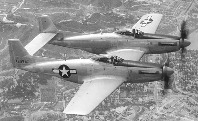
|
John A. Weeks III
Tuesday, January 13, 2026, 12:09:49 AM CST |
|||
| Home | Photo Tours | Rail Fan | 12 Easy Steps |
| Aviation | Spacecraft | Highways & Bridges | About The Author |

|
|
|||||||||||||||||
F-82 — The Twin Mustang Survivors
Of all the odd and wacky aircraft ideas that were dreamed up during
World War II, the North American P-82 has to be towards the top of the
list. In the air war with Japan, USAAF planners realized that they
were going to need ultra long duration fighter escort planes to fly
to Japan with the B-29 bombers. Since the P-51 was a great long range
escort fighter, it only made sense that two of them joined at the hip
would be an even better long range escort fighter. As it turned out,
the Marines captured islands close enough to Japan that P-51 Mustangs
were easily able to escort B-29 bombers all the way to Japan, so the
P-82 project was put on the back burner.
At first, the idea for the Twin Mustang was pretty simple. All you do is bolt two P-51's together with a piece of straight wing, and there you go. In reality, all the extra fuel needed for the long range missions lead to increasing the length of the fuselage. The higher weight meant that the wings had to be stronger. All this extra weight and power meant that the control surfaces needed to be larger. In the end, the P-82 had less than a 20% parts commonality with the P-51 mustang.

While a number of variants were built, the typical P-82 had a 51 foot 3 inch wingspan, was 38 feet 1 inch long, and just shy of 15,000 pounds empty. Gross payload was about 10,000 pounds. The flight numbers were impressive for a propeller driven fighter, max speed of 485 miles per hour, service ceiling of over 40,000 feet, and a rate of climb of 4000 feet per minute. While the USAAF, and later, the newly formed US Air Force, wanted jet fighters, they were slow coming off of the assembly line. The Air Force saw the P-82 as a solution to the problem as an interim fighter to be used until jets were more widely available. Once the USAAF became the USAF in 1947, the P-82 was redesignated F-82, with the F being for Fighter, as opposed to P for Pursuit. The F-82 went into front line service with SAC in 1948. They were quickly replaced by jet fighters, so the Twin Mustangs were sent to air defense command units in 1949. By early 1950, after only 2 years of service, the F-82 were relegated to reserve status. But, as fate would have it, the war in Korea broke out in June, 1950, and a group of F-82 Twin Mustangs were based in Japan. As it was, the F-82 was the only aircraft available in the Pacific that could cover all of Korea from bases in Japan. This was extremely lucky given that North Korea rapidly overran almost all of South Korea, including the US air bases. The first three North Korean airplanes shot down by the US were claimed by the F-82. The last F-82 Twin Mustangs were retired in 1953. A total of 273 Twin Mustangs were built. Four complete airframes survive, with two possibly being flyable. The big issue with flying the F-82 is that the two engines spin in opposite directions. The left rotating engines are all but impossible to find, and the left hand propellers are no longer available. The Confederate Air Force has been looking for a left hand propeller for nearly 20 years. F-82 Twin Mustangs On Static Display
Note—click on the Serial Number to see a photo of each airplane.
F-82 Twin Mustang Projects And Hulks
Note—click on the Serial Number to see a photo of each airplane.
|
|
|
Authored by John A. Weeks III, Copyright © 1996—2016, all rights reserved. For further information, contact: john@johnweeks.com
|